You are using an out of date browser. It may not display this or other websites correctly.
You should upgrade or use an alternative browser.
You should upgrade or use an alternative browser.
Potentially interesting STEM stuff
- Thread starter Winston
- Start date

Help Support The Rocketry Forum:
This site may earn a commission from merchant affiliate
links, including eBay, Amazon, and others.
Winston
Lorenzo von Matterhorn
- Joined
- Jan 31, 2009
- Messages
- 9,560
- Reaction score
- 1,748
Just as valid for STEM (project teamwork) as it is for military teamwork.
Jocko Willink's TEDx Talk
https://www.military.com/military-life/most-hilarious-responses-jocko-willinks-tedx-talk.html
To call former naval officer John "Jocko" Willink "intense" would be something of an understatement -- like calling Mount Everest "big" or Antarctica "cold."
Willink's 20-year military career saw the enlisted radioman rise through the ranks to command Navy SEAL teams in one of the most pivotal battles of the Iraq War.
As a commander for Task Unit Bruiser, Willink led SEALs through some of the most intense fighting of the entire war: the eight-month Battle of Ramadi, then the epicenter of the Iraqi insurgency.
That's just where the legend of Jocko began. Before retiring from the Navy in 2010, Willink would oversee the training of all West Coast SEAL teams.
His experience in both leading and following led to "Extreme Ownership: How U.S. Navy SEALs Lead and Win," a book he co-wrote with fellow SEAL Leif Babin. Today, he is the founder of the executive consulting agency Echelon Front and host of his own show, "The Jocko Podcast."
Extreme Ownership - Leadership | Jocko Willink | TEDxUniversityofNevada

Jocko Willink's TEDx Talk
https://www.military.com/military-life/most-hilarious-responses-jocko-willinks-tedx-talk.html
To call former naval officer John "Jocko" Willink "intense" would be something of an understatement -- like calling Mount Everest "big" or Antarctica "cold."
Willink's 20-year military career saw the enlisted radioman rise through the ranks to command Navy SEAL teams in one of the most pivotal battles of the Iraq War.
As a commander for Task Unit Bruiser, Willink led SEALs through some of the most intense fighting of the entire war: the eight-month Battle of Ramadi, then the epicenter of the Iraqi insurgency.
That's just where the legend of Jocko began. Before retiring from the Navy in 2010, Willink would oversee the training of all West Coast SEAL teams.
His experience in both leading and following led to "Extreme Ownership: How U.S. Navy SEALs Lead and Win," a book he co-wrote with fellow SEAL Leif Babin. Today, he is the founder of the executive consulting agency Echelon Front and host of his own show, "The Jocko Podcast."
Extreme Ownership - Leadership | Jocko Willink | TEDxUniversityofNevada

Winston
Lorenzo von Matterhorn
- Joined
- Jan 31, 2009
- Messages
- 9,560
- Reaction score
- 1,748
MARCH 27, 2020
Planetary defenders validate asteroid deflection code
https://phys.org/news/2020-03-planetary-defenders-validate-asteroid-deflection.html
Planetary defense researchers at Lawrence Livermore National Laboratory (LLNL) continue to validate their ability to accurately simulate how they might deflect an Earth-bound asteroid in a study that will be published in the April issue of the American Geophysical Union journal Earth and Space Science.
The study, led by LLNL physicist Tané Remington, also identified sensitivities in the code parameters that can help researchers working to design a modeling plan for the Double Asteroid Redirection Test (DART) mission in 2021, which will be the first-ever kinetic impact deflection demonstration on a near-Earth asteroid.
"We're preparing for something that has a very low probability of happening in our lifetimes, but a very high consequence if it were to occur," Remington said. "Time will be the enemy if we see something headed our way one day. We may have a limited window to deflect it, and we will want to be certain that we know how to avert disaster. That's what this work is all about."
This study investigated the accuracy of the codes by comparing simulation results to the data from a 1991 laboratory experiment conducted at Kyoto University, where a hyper-velocity projectile impacted a basalt sphere target.
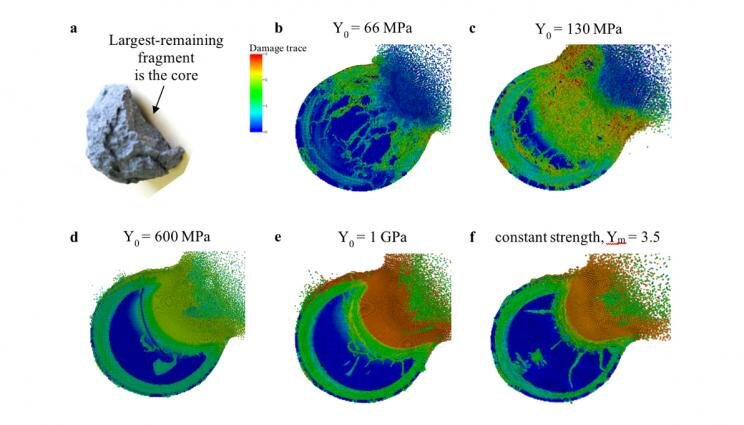
Planetary defenders validate asteroid deflection code
https://phys.org/news/2020-03-planetary-defenders-validate-asteroid-deflection.html
Planetary defense researchers at Lawrence Livermore National Laboratory (LLNL) continue to validate their ability to accurately simulate how they might deflect an Earth-bound asteroid in a study that will be published in the April issue of the American Geophysical Union journal Earth and Space Science.
The study, led by LLNL physicist Tané Remington, also identified sensitivities in the code parameters that can help researchers working to design a modeling plan for the Double Asteroid Redirection Test (DART) mission in 2021, which will be the first-ever kinetic impact deflection demonstration on a near-Earth asteroid.
"We're preparing for something that has a very low probability of happening in our lifetimes, but a very high consequence if it were to occur," Remington said. "Time will be the enemy if we see something headed our way one day. We may have a limited window to deflect it, and we will want to be certain that we know how to avert disaster. That's what this work is all about."
This study investigated the accuracy of the codes by comparing simulation results to the data from a 1991 laboratory experiment conducted at Kyoto University, where a hyper-velocity projectile impacted a basalt sphere target.

Winston
Lorenzo von Matterhorn
- Joined
- Jan 31, 2009
- Messages
- 9,560
- Reaction score
- 1,748
24 Apr 2020
Build A Sophisticated Microscope Using Lego, 3D Printing, Arduinos, and a Raspberry Pi
A DIY experiment at IBM Research–Europe became a valuable tool
https://spectrum.ieee.org/geek-life...-lego-3d-printing-arduinos-and-a-raspberry-pi
IBM open sources $300 fully-functional LEGO® microscope design
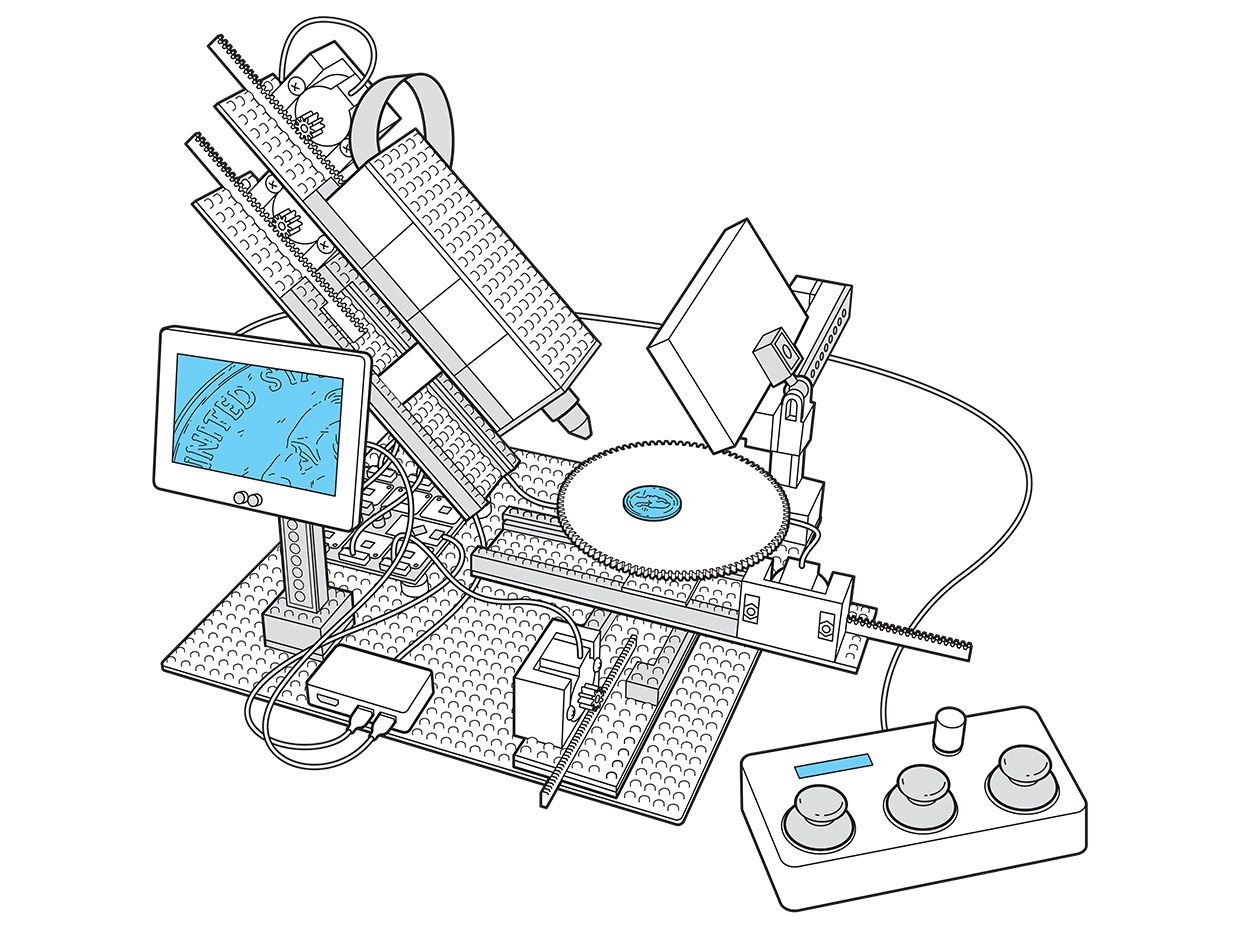
Build A Sophisticated Microscope Using Lego, 3D Printing, Arduinos, and a Raspberry Pi
A DIY experiment at IBM Research–Europe became a valuable tool
https://spectrum.ieee.org/geek-life...-lego-3d-printing-arduinos-and-a-raspberry-pi
IBM open sources $300 fully-functional LEGO® microscope design

Winston
Lorenzo von Matterhorn
- Joined
- Jan 31, 2009
- Messages
- 9,560
- Reaction score
- 1,748
Digging Up Regolith: Why Mining the Moon Seems More Possible Than Ever
For decades, the idea of mining the moon was pure science fiction for most and a wild concept for even the most ardent believers. Now technical advances and rare political support are making it an actual possibility.
https://www.popularmechanics.com/space/moon-mars/a32253706/history-moon-mining/
The moon has many attractive commodities, including metals for construction, silicon for solar panels, and Helium-3 that could be used in hypothetical fusion reactors. The prevailing idea was to mine things that are common on the moon but rare on Earth, and bring it back planetside to sell for a tidy sum.
Over time, the question became: What if the money could be made selling commodities for use in space instead of bringing them to market down the gravity well? The commodity of choice for this kind of mining was oxygen.
“The moon is 42 percent oxygen by mass and the biggest cost of spaceflight is launching oxygen,” says Metzger.
The idea was to extract oxygen for use as fuel and in life support systems but import any needed hydrogen from Earth. (NASA is still looking at this possibility.) This kind of mining can be done anywhere on the moon by scraping the O2-infused regolith. But now there is a strong case to utilize the moon’s trove of hydrogen, and that means chasing large concentrations of lunar ice collected in craters.
[snip]
The crowning mission will be 2022’s VIPER, the Volatiles Investigating Polar Exploration Rover. Armed with a suite of equipment, including a drill, this car-sized machine will help craft the first water resource map of the moon.
“Viper will provide the first and best ground-truth of our knowledge of water-ice's distribution, abundance, form, and surface environmental conditions, in an area that will either be where the Artemis [NASA’s crewed mission] astronauts land or in a very similar location,” says Stopar. “That will be the real moment of clarity that will make the pole seem like a place we can actually land and live as humans, or not.”
For decades, the idea of mining the moon was pure science fiction for most and a wild concept for even the most ardent believers. Now technical advances and rare political support are making it an actual possibility.
https://www.popularmechanics.com/space/moon-mars/a32253706/history-moon-mining/
The moon has many attractive commodities, including metals for construction, silicon for solar panels, and Helium-3 that could be used in hypothetical fusion reactors. The prevailing idea was to mine things that are common on the moon but rare on Earth, and bring it back planetside to sell for a tidy sum.
Over time, the question became: What if the money could be made selling commodities for use in space instead of bringing them to market down the gravity well? The commodity of choice for this kind of mining was oxygen.
“The moon is 42 percent oxygen by mass and the biggest cost of spaceflight is launching oxygen,” says Metzger.
The idea was to extract oxygen for use as fuel and in life support systems but import any needed hydrogen from Earth. (NASA is still looking at this possibility.) This kind of mining can be done anywhere on the moon by scraping the O2-infused regolith. But now there is a strong case to utilize the moon’s trove of hydrogen, and that means chasing large concentrations of lunar ice collected in craters.
[snip]
The crowning mission will be 2022’s VIPER, the Volatiles Investigating Polar Exploration Rover. Armed with a suite of equipment, including a drill, this car-sized machine will help craft the first water resource map of the moon.
“Viper will provide the first and best ground-truth of our knowledge of water-ice's distribution, abundance, form, and surface environmental conditions, in an area that will either be where the Artemis [NASA’s crewed mission] astronauts land or in a very similar location,” says Stopar. “That will be the real moment of clarity that will make the pole seem like a place we can actually land and live as humans, or not.”
Winston
Lorenzo von Matterhorn
- Joined
- Jan 31, 2009
- Messages
- 9,560
- Reaction score
- 1,748
APRIL 27, 2020
New findings suggest laws of nature 'downright weird,' [perhaps] not as constant as previously thought
https://phys.org/news/2020-04-laws-nature-downright-weird-constant.html
"So the universe may not be isotropic in its laws of physics—one that is the same, statistically, in all directions. But in fact, there could be some direction or preferred direction in the universe where the laws of physics change, but not in the perpendicular direction. In other words, the universe in some sense, has a dipole structure to it.
"In one particular direction, we can look back 12 billion light years and measure electromagnetism when the universe was very young. Putting all the data together, electromagnetism seems to gradually increase the further we look, while towards the opposite direction, it gradually decreases. In other directions in the cosmos, the fine structure constant remains just that—constant. These new very distant measurements have pushed our observations further than has ever been reached before."
In other words, in what was thought to be an arbitrarily random spread of galaxies, quasars, black holes, stars, gas clouds and planets—with life flourishing in at least one tiny niche of it—the universe suddenly appears to have the equivalent of a north and a south. Professor Webb is still open to the idea that somehow these measurements made at different stages using different technologies and from different locations on Earth are actually a massive coincidence.
"This is something that is taken very seriously and is regarded, quite correctly with scepticism, even by me, even though I did the first work on it with my students. But it's something you've got to test because it's possible we do live in a weird universe."
But adding to the side of the argument that says these findings are more than just coincidence, a team in the US working completely independently and unknown to Professor Webb's, made observations about X-rays that seemed to align with the idea that the universe has some sort of directionality.
"I didn't know anything about this paper until it appeared in the literature," he says.
"And they're not testing the laws of physics, they're testing the properties, the X-ray properties of galaxies and clusters of galaxies and cosmological distances from Earth. They also found that the properties of the universe in this sense are not isotropic and there's a preferred direction. And lo and behold, their direction coincides with ours."
New findings suggest laws of nature 'downright weird,' [perhaps] not as constant as previously thought
https://phys.org/news/2020-04-laws-nature-downright-weird-constant.html
"So the universe may not be isotropic in its laws of physics—one that is the same, statistically, in all directions. But in fact, there could be some direction or preferred direction in the universe where the laws of physics change, but not in the perpendicular direction. In other words, the universe in some sense, has a dipole structure to it.
"In one particular direction, we can look back 12 billion light years and measure electromagnetism when the universe was very young. Putting all the data together, electromagnetism seems to gradually increase the further we look, while towards the opposite direction, it gradually decreases. In other directions in the cosmos, the fine structure constant remains just that—constant. These new very distant measurements have pushed our observations further than has ever been reached before."
In other words, in what was thought to be an arbitrarily random spread of galaxies, quasars, black holes, stars, gas clouds and planets—with life flourishing in at least one tiny niche of it—the universe suddenly appears to have the equivalent of a north and a south. Professor Webb is still open to the idea that somehow these measurements made at different stages using different technologies and from different locations on Earth are actually a massive coincidence.
"This is something that is taken very seriously and is regarded, quite correctly with scepticism, even by me, even though I did the first work on it with my students. But it's something you've got to test because it's possible we do live in a weird universe."
But adding to the side of the argument that says these findings are more than just coincidence, a team in the US working completely independently and unknown to Professor Webb's, made observations about X-rays that seemed to align with the idea that the universe has some sort of directionality.
"I didn't know anything about this paper until it appeared in the literature," he says.
"And they're not testing the laws of physics, they're testing the properties, the X-ray properties of galaxies and clusters of galaxies and cosmological distances from Earth. They also found that the properties of the universe in this sense are not isotropic and there's a preferred direction. And lo and behold, their direction coincides with ours."
Winston
Lorenzo von Matterhorn
- Joined
- Jan 31, 2009
- Messages
- 9,560
- Reaction score
- 1,748
Man Killed by Falling Meteorite (in 1888)
Scientists finally unearthed the first-ever record of death by meteorite strike
https://www.popularmechanics.com/science/a31248702/first-confirmed-meteorite-death/
Determined researchers have found what they say is the first confirmed evidence from the historical record of a human being killed by a falling meteorite. The documentation had been hiding in plain sight in an ornate, elite form of Turkish that’s hard to translate. The researchers say this represents a step forward in the study and translation of the historic record in order to corroborate with the scientific record.
“Well-documented stories of meteorite-caused injury or death are rare,” NASA explains. “In the first known case of an extraterrestrial object to have injured a human being in the U.S., Ann Hodges of Sylacauga, Alabama, was severely bruised by a 8-pound (3.6-kilogram) stony meteorite that crashed through her roof in November 1954.”
That tidbit will change if NASA validates the claims of corresponding author Ozan Ünsalan and his colleagues. Ünsalan is an eclectic physicist, and his two coauthors are a Turkish academic historian and a meteor astronomer from SETI’s Carl Sagan Center. SETI, the Search for Extraterrestrial Intelligence, operates the Cameras for Allsky Meteor Surveillance (CAMS) network.
Monitoring meteorites has always been part of SETI’s mission. By combining historical information about meteorites and translation skills, these researchers say they’ve verified a reported death by meteorite that happened in 1888. Ideally, they’d also have a physical rock that can be studied to show it is from outer space.
But they don’t have that rock, which represents a potentially big sticking point. They do, however, have three independent accounts of the events from local governments, and witnesses saw the meteor shower while it rained fiery rocks on one village for up to 10 minutes. One man was killed, according to the reports, and another was struck and paralyzed.
But three matching reports from different officials is pretty compelling. Why did it take so long for these accounts to come to light? Well, they’re written in the official language of the Ottoman Empire at the time, Ottoman Turkish, which uses a complex alphabet based on Persian Arabic. Back then, common people usually spoke traditional Turkish, creating a duality between that and formal Ottoman Turkish.
The True Story of History's Only Known Meteorite Victim
Ann Hodges was hit by a meteorite in her Alabama home in 1954.
https://www.nationalgeographic.com/news/2013/2/130220-russia-meteorite-ann-hodges-science-space-hit/
On a clear afternoon in Sylacauga, Alabama (see map) in 1954, Ann was napping on her couch, covered by quilts, when a softball-size hunk of black rock broke through the ceiling, bounced off a radio, and hit her in the thigh, leaving a pineapple-shaped bruise.

Scientists finally unearthed the first-ever record of death by meteorite strike
https://www.popularmechanics.com/science/a31248702/first-confirmed-meteorite-death/
Determined researchers have found what they say is the first confirmed evidence from the historical record of a human being killed by a falling meteorite. The documentation had been hiding in plain sight in an ornate, elite form of Turkish that’s hard to translate. The researchers say this represents a step forward in the study and translation of the historic record in order to corroborate with the scientific record.
“Well-documented stories of meteorite-caused injury or death are rare,” NASA explains. “In the first known case of an extraterrestrial object to have injured a human being in the U.S., Ann Hodges of Sylacauga, Alabama, was severely bruised by a 8-pound (3.6-kilogram) stony meteorite that crashed through her roof in November 1954.”
That tidbit will change if NASA validates the claims of corresponding author Ozan Ünsalan and his colleagues. Ünsalan is an eclectic physicist, and his two coauthors are a Turkish academic historian and a meteor astronomer from SETI’s Carl Sagan Center. SETI, the Search for Extraterrestrial Intelligence, operates the Cameras for Allsky Meteor Surveillance (CAMS) network.
Monitoring meteorites has always been part of SETI’s mission. By combining historical information about meteorites and translation skills, these researchers say they’ve verified a reported death by meteorite that happened in 1888. Ideally, they’d also have a physical rock that can be studied to show it is from outer space.
But they don’t have that rock, which represents a potentially big sticking point. They do, however, have three independent accounts of the events from local governments, and witnesses saw the meteor shower while it rained fiery rocks on one village for up to 10 minutes. One man was killed, according to the reports, and another was struck and paralyzed.
But three matching reports from different officials is pretty compelling. Why did it take so long for these accounts to come to light? Well, they’re written in the official language of the Ottoman Empire at the time, Ottoman Turkish, which uses a complex alphabet based on Persian Arabic. Back then, common people usually spoke traditional Turkish, creating a duality between that and formal Ottoman Turkish.
The True Story of History's Only Known Meteorite Victim
Ann Hodges was hit by a meteorite in her Alabama home in 1954.
https://www.nationalgeographic.com/news/2013/2/130220-russia-meteorite-ann-hodges-science-space-hit/
On a clear afternoon in Sylacauga, Alabama (see map) in 1954, Ann was napping on her couch, covered by quilts, when a softball-size hunk of black rock broke through the ceiling, bounced off a radio, and hit her in the thigh, leaving a pineapple-shaped bruise.

Winston
Lorenzo von Matterhorn
- Joined
- Jan 31, 2009
- Messages
- 9,560
- Reaction score
- 1,748
RESEARCHERS WANT TO EXPLORE MARS USING “NANOCARDBOARD” AIRCRAFT
23 Apr 2020
https://futurism.com/the-byte/explore-mars-nanocardboard-aircraft
Researchers at the University of Pennsylvania say we could one day explore the surface of Mars using a fleet of “nanocardboard” aircraft that each weigh as much as a fruit fly and feature no moving parts.
The tiny flyers, as outlined in the study first published in the journal Advanced Materials in February, work by harnessing the power of temperature differentials between the upper and lower side. When a bright light like the Sun shines on one side, it heats up, circulating air through corrugated channels — hence “cardboard” — and providing thrust.
So far, the researchers managed to fly tiny payloads in the form of silicone rings, inside a low-pressure test chamber that simulates the Martian environment. The team is now working on miniaturizing chemical sensors that the tiny flyers could use to detect water on Mars.
Tiny, levitating 'nanocardboard' aircraft could explore Mars one day
23 Apr 2020
https://www.space.com/mars-nanocardboard-flying-aircraft-helicopter.html
Tiny, levitating "nanocardboard" flyers could one day explore the dusty red surface of Mars.
Each tiny flyer is a plate of "nanocardboard," which is inspired by paper cardboard's corrugations, or ridges. Plates of "nanocardboard" are hollow aluminum oxide a few nanometers thick with ridges made by a pattern of micro-channels on the plates that keep them stiff and unbroken.
The micro-channels in the "nanocardboard" plates are actually the secret behind their unique method of flight, according to the statement: The channels create a temperature gradient that pushes air through the hollow plates and allows them to float.
This strange method of flight would be particularly advantageous on Mars because the planet's thin atmosphere and weaker gravity would allow the plates to lift more weight and travel over much longer distances than here on Earth.
In this study, the researchers tested "nanocardboard" vehicles in a Mars-like environment in a lab environment. They tested the vehicles in a low-pressure test chamber and experimented with mock payloads by having the little floating plates carry silicone rings.
Additionally, Bargatin is working with other researchers to develop new, tinier chemical sensors that could collect important data and detect substances like methane and water on other planets, according to the statement.
"In addition to carrying sensors," Bargatin said, "our flyers could simply land and have grains of dust or sand passively stick to them, then transport them back to the rover so it doesn't need to travel as far."

23 Apr 2020
https://futurism.com/the-byte/explore-mars-nanocardboard-aircraft
Researchers at the University of Pennsylvania say we could one day explore the surface of Mars using a fleet of “nanocardboard” aircraft that each weigh as much as a fruit fly and feature no moving parts.
The tiny flyers, as outlined in the study first published in the journal Advanced Materials in February, work by harnessing the power of temperature differentials between the upper and lower side. When a bright light like the Sun shines on one side, it heats up, circulating air through corrugated channels — hence “cardboard” — and providing thrust.
So far, the researchers managed to fly tiny payloads in the form of silicone rings, inside a low-pressure test chamber that simulates the Martian environment. The team is now working on miniaturizing chemical sensors that the tiny flyers could use to detect water on Mars.
Tiny, levitating 'nanocardboard' aircraft could explore Mars one day
23 Apr 2020
https://www.space.com/mars-nanocardboard-flying-aircraft-helicopter.html
Tiny, levitating "nanocardboard" flyers could one day explore the dusty red surface of Mars.
Each tiny flyer is a plate of "nanocardboard," which is inspired by paper cardboard's corrugations, or ridges. Plates of "nanocardboard" are hollow aluminum oxide a few nanometers thick with ridges made by a pattern of micro-channels on the plates that keep them stiff and unbroken.
The micro-channels in the "nanocardboard" plates are actually the secret behind their unique method of flight, according to the statement: The channels create a temperature gradient that pushes air through the hollow plates and allows them to float.
This strange method of flight would be particularly advantageous on Mars because the planet's thin atmosphere and weaker gravity would allow the plates to lift more weight and travel over much longer distances than here on Earth.
In this study, the researchers tested "nanocardboard" vehicles in a Mars-like environment in a lab environment. They tested the vehicles in a low-pressure test chamber and experimented with mock payloads by having the little floating plates carry silicone rings.
Additionally, Bargatin is working with other researchers to develop new, tinier chemical sensors that could collect important data and detect substances like methane and water on other planets, according to the statement.
"In addition to carrying sensors," Bargatin said, "our flyers could simply land and have grains of dust or sand passively stick to them, then transport them back to the rover so it doesn't need to travel as far."

Winston
Lorenzo von Matterhorn
- Joined
- Jan 31, 2009
- Messages
- 9,560
- Reaction score
- 1,748
24 Apr 2020
Here Are the U.S. Regions Most Vulnerable to Solar Storms
Grid operators in Minnesota, North Dakota, and Wisconsin should take extra precautions against solar "weather"
https://spectrum.ieee.org/energywise/energy/the-smarter-grid/us-regions-most-vulnerable-solar-storms
A new study about solar-induced power outages in the U.S. electric grid finds that a few key regions—a portion of the American midwest and Eastern U.S. seaboard—appear to be more vulnerable than others.
The good news is that a few preventative measures could drastically reduce the damage done when a solar storm hits Earth. Those include stockpiling electrical transformers in national strategic reserves.
Depending on the geology of a given region, the currents a geomagnetic storm induces in the power lines can destabilize the power grid’s operation and cause damage to (or even destroy) transformers.
Fortunately some kinds of rock, such as sedimentary formations, are relatively electrically conductive. Which means they’re more effective at dissipating storm-induced electric fields. And so the regions of the country with more of these conducting-type rocks will be more resilient to a magnetic storm. As it happens, that’s most of the United States.
Some regions with bad geological luck, however, happen to have more electrically resistive rock (including igneous and metamorphic formations) in the ground. And that means high-voltage electrical wires in those parts of the country will be more subject to geomagnetic disturbances from solar flares. Utilities in those regions need to know that power disturbances and outages—and possibly blown transformers—are more likely in the case of a big solar storm hitting Earth.
In a worst-case scenario, Love said, portions of the electric grid without enough backup transformers and other equipment could find themselves unable to operate until they can swap in backup systems. Of course, if there are not enough transformers and other devices, many in the hardest-hit regions could be without power for days or weeks until equipment could be delivered or built from scratch.
Here Are the U.S. Regions Most Vulnerable to Solar Storms
Grid operators in Minnesota, North Dakota, and Wisconsin should take extra precautions against solar "weather"
https://spectrum.ieee.org/energywise/energy/the-smarter-grid/us-regions-most-vulnerable-solar-storms
A new study about solar-induced power outages in the U.S. electric grid finds that a few key regions—a portion of the American midwest and Eastern U.S. seaboard—appear to be more vulnerable than others.
The good news is that a few preventative measures could drastically reduce the damage done when a solar storm hits Earth. Those include stockpiling electrical transformers in national strategic reserves.
Depending on the geology of a given region, the currents a geomagnetic storm induces in the power lines can destabilize the power grid’s operation and cause damage to (or even destroy) transformers.
Fortunately some kinds of rock, such as sedimentary formations, are relatively electrically conductive. Which means they’re more effective at dissipating storm-induced electric fields. And so the regions of the country with more of these conducting-type rocks will be more resilient to a magnetic storm. As it happens, that’s most of the United States.
Some regions with bad geological luck, however, happen to have more electrically resistive rock (including igneous and metamorphic formations) in the ground. And that means high-voltage electrical wires in those parts of the country will be more subject to geomagnetic disturbances from solar flares. Utilities in those regions need to know that power disturbances and outages—and possibly blown transformers—are more likely in the case of a big solar storm hitting Earth.
In a worst-case scenario, Love said, portions of the electric grid without enough backup transformers and other equipment could find themselves unable to operate until they can swap in backup systems. Of course, if there are not enough transformers and other devices, many in the hardest-hit regions could be without power for days or weeks until equipment could be delivered or built from scratch.
Winston
Lorenzo von Matterhorn
- Joined
- Jan 31, 2009
- Messages
- 9,560
- Reaction score
- 1,748
Looks like it rapidly intensified greatly in the last seconds before and after it hit the town. The flags look like they survived although they might be a bit frayed.
CLOSE TORNADO TEARS THROUGH TOWN - Madill, Oklahoma 4-22-20
Extreme up close tornado in Madill Oklahoma on April 22, 2020. This tornado damaged town structures and lofted trees into the air before transitioning to a rope phase. Many people observed a rainbow with this tornado. Moments after the tornado struck, the sky was blue and sunny. Unfortunately it was reported that at least one person has lost their life from this twister.
Soso Mississippi Tornado - 4-12-20 - Invisible EF4 Horror
HOW LIGHTNING WORKS - Weird World of Lightning (4K) - 3-26-20
CLOSE TORNADO TEARS THROUGH TOWN - Madill, Oklahoma 4-22-20
Extreme up close tornado in Madill Oklahoma on April 22, 2020. This tornado damaged town structures and lofted trees into the air before transitioning to a rope phase. Many people observed a rainbow with this tornado. Moments after the tornado struck, the sky was blue and sunny. Unfortunately it was reported that at least one person has lost their life from this twister.
Soso Mississippi Tornado - 4-12-20 - Invisible EF4 Horror
HOW LIGHTNING WORKS - Weird World of Lightning (4K) - 3-26-20
Winston
Lorenzo von Matterhorn
- Joined
- Jan 31, 2009
- Messages
- 9,560
- Reaction score
- 1,748
NASA’s Mars Helicopter, Ingenuity
Mars Helicopter
https://mars.nasa.gov/technology/helicopter/
Deployment test video:
https://mars.nasa.gov/layout/helicopter/images/HowTheMarsHelicopterIsReleased-1280.m4v
https://techcrunch.com/2020/04/30/h...th-the-first-extraterrestrial-powered-flight/
Ingenuity may look like a simple dual rotor drone, but it’s actually a groundbreaking piece of engineering that has to overcome significant technical challenges in order to complete its mission of performing short-altitude “hops” on Mars. That’s its sole goal, and the 4-lb craft doesn’t have any other instruments on board, as it’s essentially a demonstrator that will set up the design and development of future aerial exploration craft to help with the study of Mars.
Even flying the softball-sized main body of Ingenuity is an achievement, because flying on Mars requires much more lift than it does here on Earth due to the nature of the planet’s atmosphere. Accordingly, the helicopter’s test flights will only last around 90 seconds each, and climb to a height of just 16.5 feet — easy here at home, but roughly equivalent to flying at around 100,000 feet on Earth — much higher than most commercial aircraft.
Mars Helicopter
https://mars.nasa.gov/technology/helicopter/
Deployment test video:
https://mars.nasa.gov/layout/helicopter/images/HowTheMarsHelicopterIsReleased-1280.m4v
https://techcrunch.com/2020/04/30/h...th-the-first-extraterrestrial-powered-flight/
Ingenuity may look like a simple dual rotor drone, but it’s actually a groundbreaking piece of engineering that has to overcome significant technical challenges in order to complete its mission of performing short-altitude “hops” on Mars. That’s its sole goal, and the 4-lb craft doesn’t have any other instruments on board, as it’s essentially a demonstrator that will set up the design and development of future aerial exploration craft to help with the study of Mars.
Even flying the softball-sized main body of Ingenuity is an achievement, because flying on Mars requires much more lift than it does here on Earth due to the nature of the planet’s atmosphere. Accordingly, the helicopter’s test flights will only last around 90 seconds each, and climb to a height of just 16.5 feet — easy here at home, but roughly equivalent to flying at around 100,000 feet on Earth — much higher than most commercial aircraft.
Winston
Lorenzo von Matterhorn
- Joined
- Jan 31, 2009
- Messages
- 9,560
- Reaction score
- 1,748
APRIL 30, 2020
'Gargantuan' hail in Argentina may have smashed world record
https://phys.org/news/2020-04-gargantuan-hail-argentina-world.html
A supercell thunderstorm pelted a city center in Argentina a few years ago with hailstones so large scientists suggested a new category to describe them—gargantuan hail.
Researchers investigating the 2018 storm found one hailstone likely measured between 7.4 and 9.3 inches across, potentially setting a new world record. The current record belongs to a hailstone that measured 8 inches across, or about the size of a volleyball, that fell near Vivian, South Dakota.
"It's incredible," said Matthew Kumjian, associate professor in the Department of Meteorology and Atmosphere Science at Penn State. "This is the extreme upper end of what you'd expect from hail."
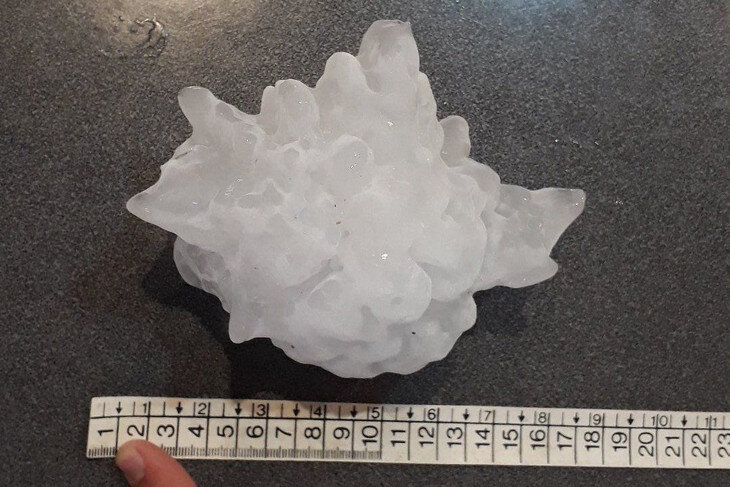
'Gargantuan' hail in Argentina may have smashed world record
https://phys.org/news/2020-04-gargantuan-hail-argentina-world.html
A supercell thunderstorm pelted a city center in Argentina a few years ago with hailstones so large scientists suggested a new category to describe them—gargantuan hail.
Researchers investigating the 2018 storm found one hailstone likely measured between 7.4 and 9.3 inches across, potentially setting a new world record. The current record belongs to a hailstone that measured 8 inches across, or about the size of a volleyball, that fell near Vivian, South Dakota.
"It's incredible," said Matthew Kumjian, associate professor in the Department of Meteorology and Atmosphere Science at Penn State. "This is the extreme upper end of what you'd expect from hail."

Winston
Lorenzo von Matterhorn
- Joined
- Jan 31, 2009
- Messages
- 9,560
- Reaction score
- 1,748
Lunar Flashlight
https://www.jpl.nasa.gov/missions/lunar-flashlight/
Roughly the size of a briefcase, Lunar Flashlight is a very small satellite being developed and managed by NASA's Jet Propulsion Laboratory that will use near-infrared lasers and an onboard spectrometer to map ice in permanently shadowed regions near the Moon's south pole. The observations made by the low-cost mission will provide unambiguous information about the presence of water ice deposits inside craters that would be an valuable in-situ resource for future Artemis missions to the lunar surface.
As a technology demonstration mission, Lunar Flashlight will showcase several technological firsts, including being the first mission to look for water ice using a laser reflectometer and the first planetary CubeSat mission to use "green" propulsion - a propellant that is less toxic and safer than hydrazine, a common propellant used by spacecraft.
The mission was selected by NASA's Advanced Exploration Systems in 2014 and is currently funded by the Small Spacecraft Technology program within NASA's Space Technology Mission Directorate. Lunar Flashlight will be one of the 13 secondary payloads aboard Artemis I, the first integrated flight test of NASA's Deep Space Exploration Systems, including the Orion spacecraft and Space Launch System (SLS) rocket launching from the newly upgraded Exploration Ground Systems at NASA's Kennedy Space Center in Florida.
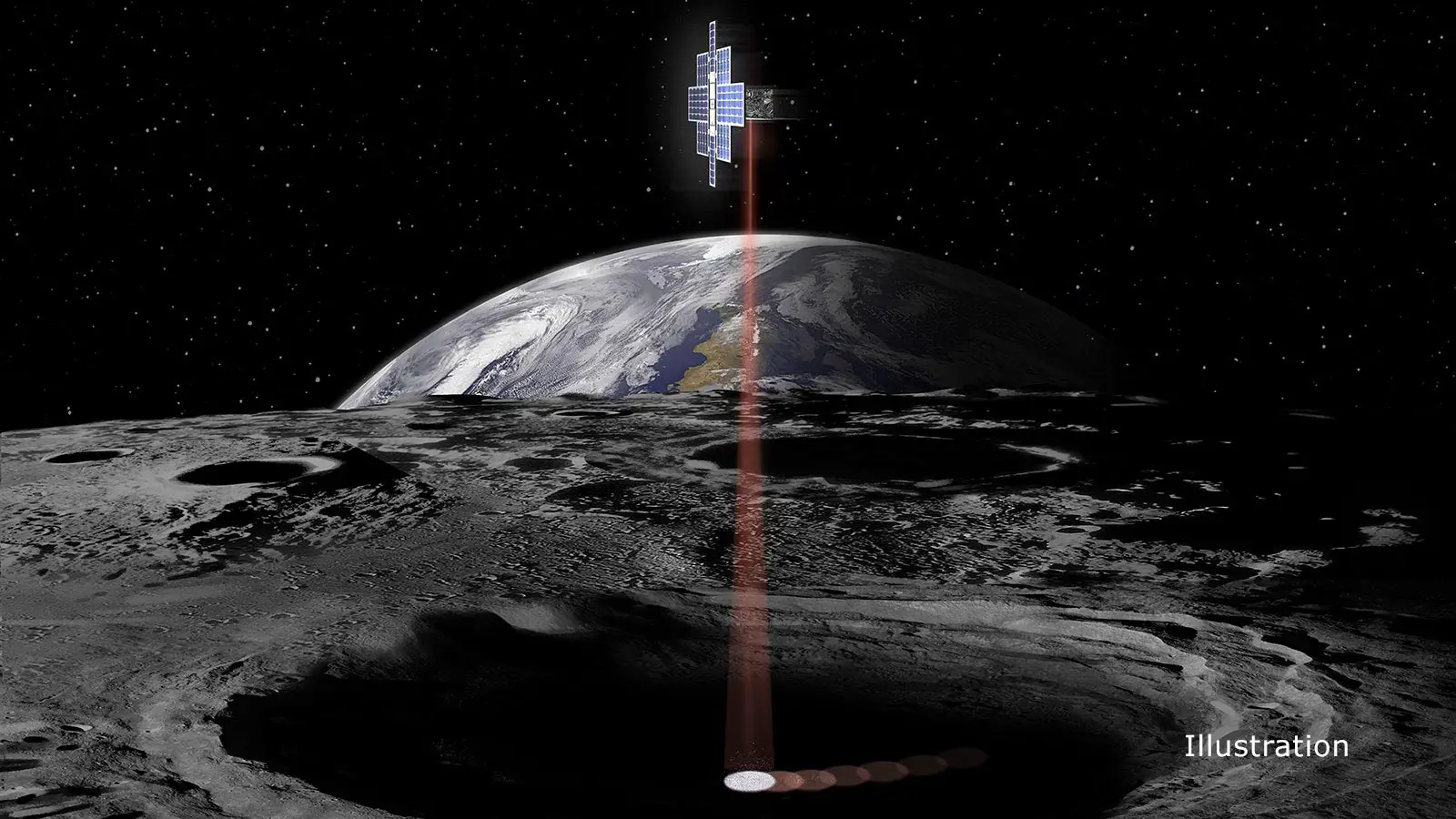

https://www.jpl.nasa.gov/missions/lunar-flashlight/
Roughly the size of a briefcase, Lunar Flashlight is a very small satellite being developed and managed by NASA's Jet Propulsion Laboratory that will use near-infrared lasers and an onboard spectrometer to map ice in permanently shadowed regions near the Moon's south pole. The observations made by the low-cost mission will provide unambiguous information about the presence of water ice deposits inside craters that would be an valuable in-situ resource for future Artemis missions to the lunar surface.
As a technology demonstration mission, Lunar Flashlight will showcase several technological firsts, including being the first mission to look for water ice using a laser reflectometer and the first planetary CubeSat mission to use "green" propulsion - a propellant that is less toxic and safer than hydrazine, a common propellant used by spacecraft.
The mission was selected by NASA's Advanced Exploration Systems in 2014 and is currently funded by the Small Spacecraft Technology program within NASA's Space Technology Mission Directorate. Lunar Flashlight will be one of the 13 secondary payloads aboard Artemis I, the first integrated flight test of NASA's Deep Space Exploration Systems, including the Orion spacecraft and Space Launch System (SLS) rocket launching from the newly upgraded Exploration Ground Systems at NASA's Kennedy Space Center in Florida.


Winston
Lorenzo von Matterhorn
- Joined
- Jan 31, 2009
- Messages
- 9,560
- Reaction score
- 1,748
The technological singularity begins?
AI Designs Computer Chips for More Powerful AI
Google’s breakthrough could dramatically accelerate the design cycle for intelligent machines
30 Apr 2020
https://www.discovermagazine.com/technology/ai-designs-computer-chips-for-more-powerful-ai
One emerging trend in chip design is a move away from bigger, grander designs that double the number of transistors every 18 months, as Moore’s Law stipulates. Instead, there is growing interest in specialized chips for specific tasks such as AI and machine learning, which are advancing rapidly on scales measured in weeks and months.
But chips take much longer than this to design, and that means new microprocessors cannot be designed quickly enough to reflect current thinking. “Today’s chips take years to design, leaving us with the speculative task of optimizing them for the machine learning models of two to five years from now,” lament Azalia Mirhoseini, Anna Goldie and colleagues at Google, who have come up with a novel way to speed up this process.
Their new approach is to use AI itself to speed up the process of chip design. And the results are impressive. Their machine learning algorithm can do in six hours what a human chip designer would take weeks to achieve, even when using modern chip-design software.
And the implications are significant. “We believe that it is AI itself that will provide the means to shorten the chip design cycle, creating a symbiotic relationship between hardware and AI with each fueling advances in the other,” say Mirhoseini, Goldie and colleagues.
[snip]
In this way, the team built a database of 10,000 chip designs, along with their wirelengths, congestion levels, et cetera. They next use this database to train a machine learning algorithm to predict the wirelength, congestion levels, and so on, for a given design. It then further learns how to fine-tune the design to make it better.
The designs are as good as, or even better than, what humans can manage. The algorithm even learns the same rules of thumb that human expert designers have long known through intuition. For example, the machine distributes the larger macros around the edges of a chip, leaving an empty central region for the messier network of standard logic gates. For humans, this intuitively reduces wirelength.
The result is a machine learning algorithm that can turn a massive, complex netlist into an optimized physical chip design in about six hours. By comparison, conventional chip design, which is already highly automated but requires a human in the loop, takes several weeks.
Just don't put them in charge of nukes:
AI Designs Computer Chips for More Powerful AI
Google’s breakthrough could dramatically accelerate the design cycle for intelligent machines
30 Apr 2020
https://www.discovermagazine.com/technology/ai-designs-computer-chips-for-more-powerful-ai
One emerging trend in chip design is a move away from bigger, grander designs that double the number of transistors every 18 months, as Moore’s Law stipulates. Instead, there is growing interest in specialized chips for specific tasks such as AI and machine learning, which are advancing rapidly on scales measured in weeks and months.
But chips take much longer than this to design, and that means new microprocessors cannot be designed quickly enough to reflect current thinking. “Today’s chips take years to design, leaving us with the speculative task of optimizing them for the machine learning models of two to five years from now,” lament Azalia Mirhoseini, Anna Goldie and colleagues at Google, who have come up with a novel way to speed up this process.
Their new approach is to use AI itself to speed up the process of chip design. And the results are impressive. Their machine learning algorithm can do in six hours what a human chip designer would take weeks to achieve, even when using modern chip-design software.
And the implications are significant. “We believe that it is AI itself that will provide the means to shorten the chip design cycle, creating a symbiotic relationship between hardware and AI with each fueling advances in the other,” say Mirhoseini, Goldie and colleagues.
[snip]
In this way, the team built a database of 10,000 chip designs, along with their wirelengths, congestion levels, et cetera. They next use this database to train a machine learning algorithm to predict the wirelength, congestion levels, and so on, for a given design. It then further learns how to fine-tune the design to make it better.
The designs are as good as, or even better than, what humans can manage. The algorithm even learns the same rules of thumb that human expert designers have long known through intuition. For example, the machine distributes the larger macros around the edges of a chip, leaving an empty central region for the messier network of standard logic gates. For humans, this intuitively reduces wirelength.
The result is a machine learning algorithm that can turn a massive, complex netlist into an optimized physical chip design in about six hours. By comparison, conventional chip design, which is already highly automated but requires a human in the loop, takes several weeks.
Just don't put them in charge of nukes:
Winston
Lorenzo von Matterhorn
- Joined
- Jan 31, 2009
- Messages
- 9,560
- Reaction score
- 1,748
NASA's Perseverance Rover Will Look at Mars Through These 'Eyes'
1 May 2020
https://mars.nasa.gov/news/8663/nasas-perseverance-rover-will-look-at-mars-through-these-eyes/
When it launches this summer, NASA's Perseverance rover will have the most advanced pair of "eyes" ever sent to the Red Planet's surface: Its Mastcam-Z instrument packs a next-gen zoom capability that will help the mission make 3D imagery more easily. Rover operators, who carefully plan out each driving route and each movement of a rover's robotic arm, view these stereo images through 3D goggles to see the contours of the landscape.
Curiosity's Mastcam was initially designed to be zoomable, but that proved difficult to achieve at the time in such a small instrument (Curiosity launched in 2011).
"The original plan was for Curiosity to have a zoom camera that could go out to an extreme wide angle like a spaghetti western view," said Jim Bell of Arizona State University, Mastcam-Z's principal investigator and Mastcam's deputy principal investigator. "It would have been an amazing panoramic perspective but proved really hard to build at the time."
Instead, Curiosity's Mastcam has one telephoto lens and one wide-angle lens. Images are taken through each and can be combined to produce stereo views. But the wide-angle lens takes in far more of the landscape in a single shot than the telescopic one; it requires up to nine telescopic images to match.
Perseverance's Mastcam-Z simplifies matters, zooming both lenses until they match and can be used to make a single 3D image. This is both easier and requires sending fewer images — and less data — to Earth.
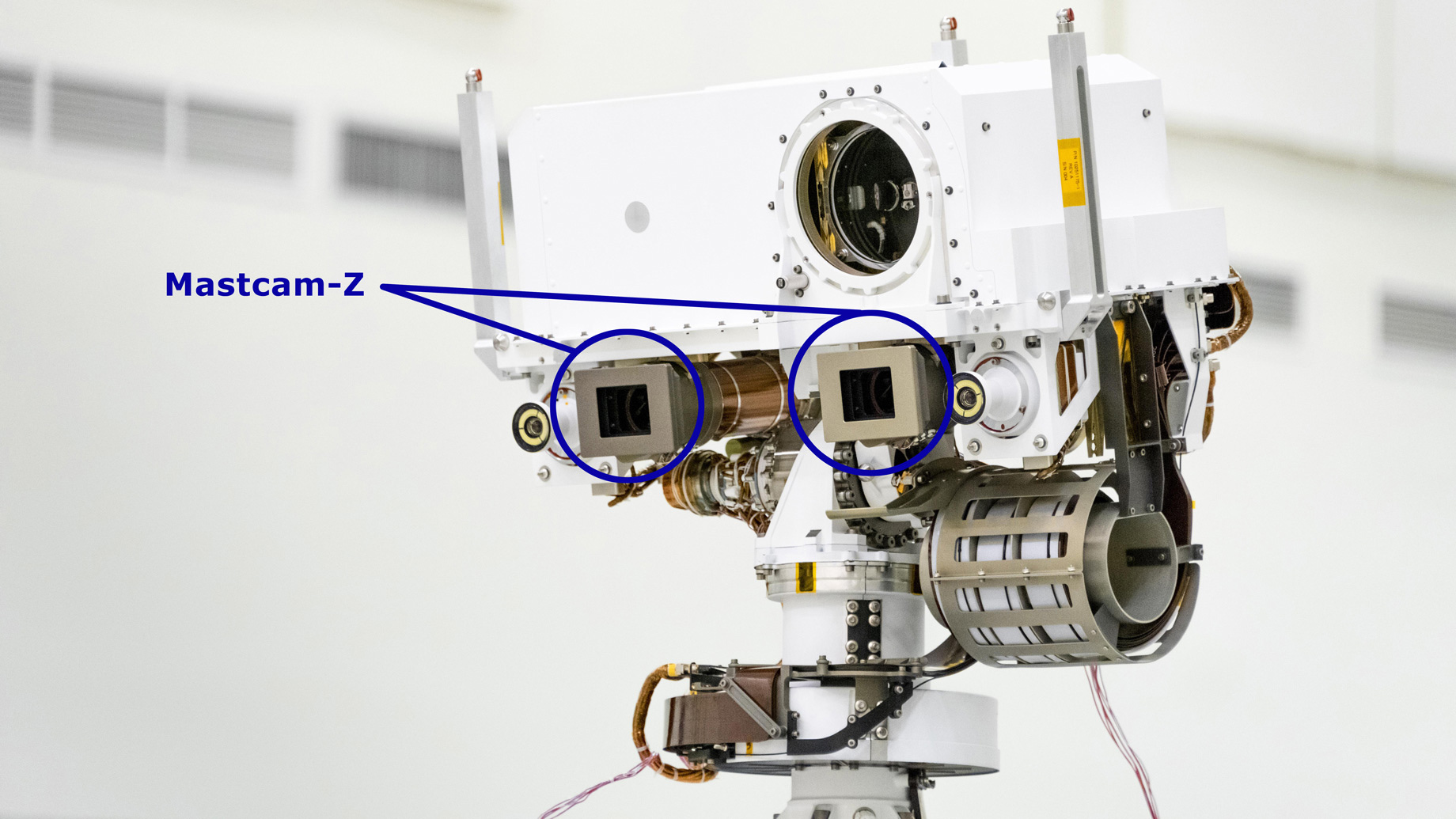
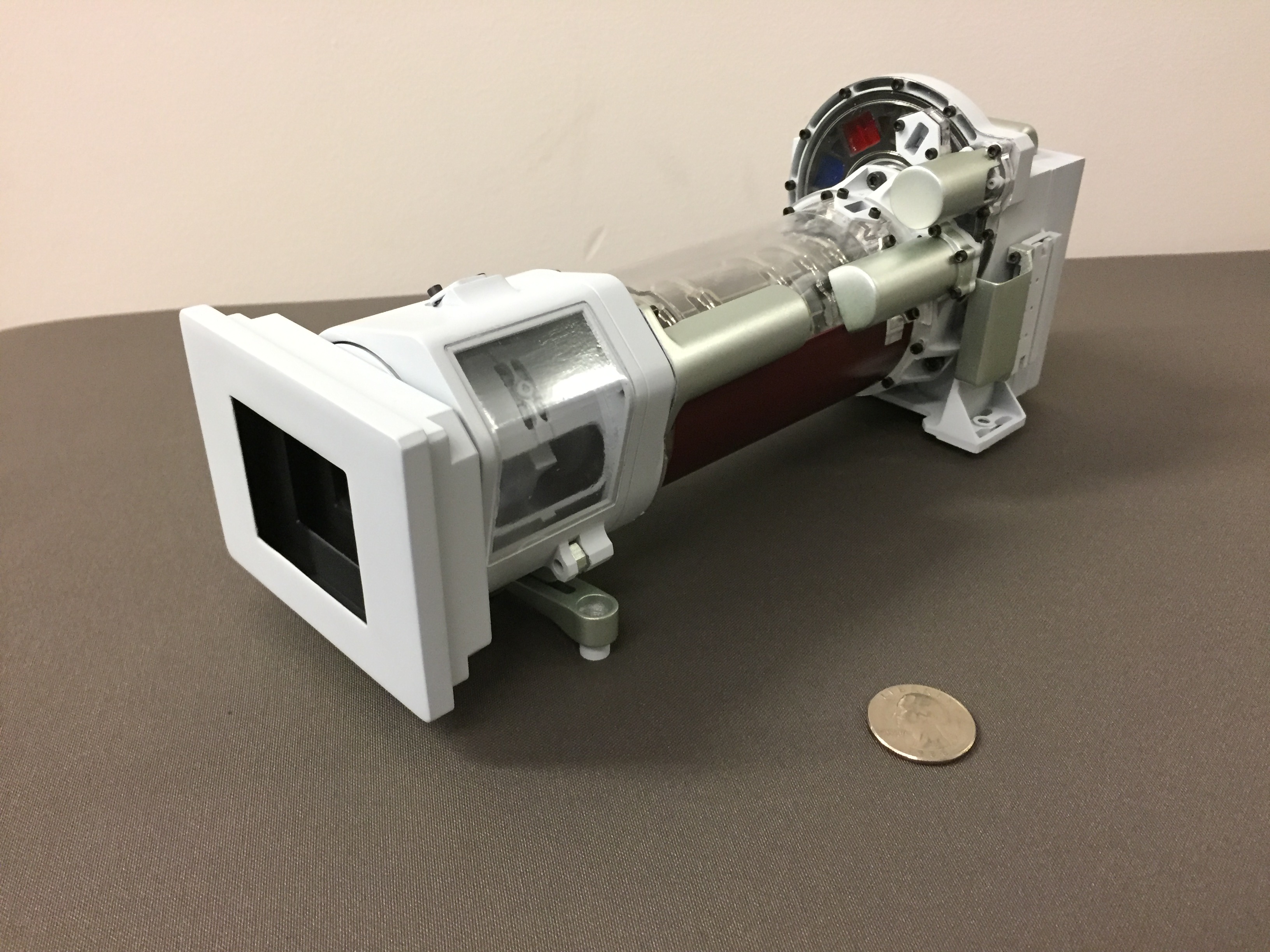
1 May 2020
https://mars.nasa.gov/news/8663/nasas-perseverance-rover-will-look-at-mars-through-these-eyes/
When it launches this summer, NASA's Perseverance rover will have the most advanced pair of "eyes" ever sent to the Red Planet's surface: Its Mastcam-Z instrument packs a next-gen zoom capability that will help the mission make 3D imagery more easily. Rover operators, who carefully plan out each driving route and each movement of a rover's robotic arm, view these stereo images through 3D goggles to see the contours of the landscape.
Curiosity's Mastcam was initially designed to be zoomable, but that proved difficult to achieve at the time in such a small instrument (Curiosity launched in 2011).
"The original plan was for Curiosity to have a zoom camera that could go out to an extreme wide angle like a spaghetti western view," said Jim Bell of Arizona State University, Mastcam-Z's principal investigator and Mastcam's deputy principal investigator. "It would have been an amazing panoramic perspective but proved really hard to build at the time."
Instead, Curiosity's Mastcam has one telephoto lens and one wide-angle lens. Images are taken through each and can be combined to produce stereo views. But the wide-angle lens takes in far more of the landscape in a single shot than the telescopic one; it requires up to nine telescopic images to match.
Perseverance's Mastcam-Z simplifies matters, zooming both lenses until they match and can be used to make a single 3D image. This is both easier and requires sending fewer images — and less data — to Earth.


Winston
Lorenzo von Matterhorn
- Joined
- Jan 31, 2009
- Messages
- 9,560
- Reaction score
- 1,748
How amateur satellite trackers are keeping an 'eye' on objects around the Earth
3 May 2020
https://www.space.com/amateur-satellite-trackers-on-global-lookout.html
Around the planet, a loosely knit but closely woven band of amateurs monitor the whereabouts of satellites — be they secretive spacecraft, robotic space drones, rocket stages, orbital debris or lost-in-space planetary probes.
But what's the motivation behind this group of sky prowling spirits? What kind of tools are they using now or in the future to purge secrets from space — at times revealing what some countries don't want others to know about?
Space.com reached out to a small set of these hobbyists that contribute to SeeSat-L, a mailing list intended to facilitate rapid, reliable communications among a worldwide cadre of visual satellite observers.
3 May 2020
https://www.space.com/amateur-satellite-trackers-on-global-lookout.html
Around the planet, a loosely knit but closely woven band of amateurs monitor the whereabouts of satellites — be they secretive spacecraft, robotic space drones, rocket stages, orbital debris or lost-in-space planetary probes.
But what's the motivation behind this group of sky prowling spirits? What kind of tools are they using now or in the future to purge secrets from space — at times revealing what some countries don't want others to know about?
Space.com reached out to a small set of these hobbyists that contribute to SeeSat-L, a mailing list intended to facilitate rapid, reliable communications among a worldwide cadre of visual satellite observers.
Winston
Lorenzo von Matterhorn
- Joined
- Jan 31, 2009
- Messages
- 9,560
- Reaction score
- 1,748
MAY 8, 2020
NASA's Perseverance rover spacecraft put in launch configuration
https://phys.org/news/2020-05-nasa-perseverance-rover-spacecraft-configuration.html
Engineers working on NASA's Perseverance rover mission at the Kennedy Space Center in Florida have begun the process of placing the Mars-bound rover and other spacecraft components into the configuration they'll be in as they ride on top of the United Launch Alliance Atlas V rocket. The launch period for the mission opens on July 17—just 70 days from now.
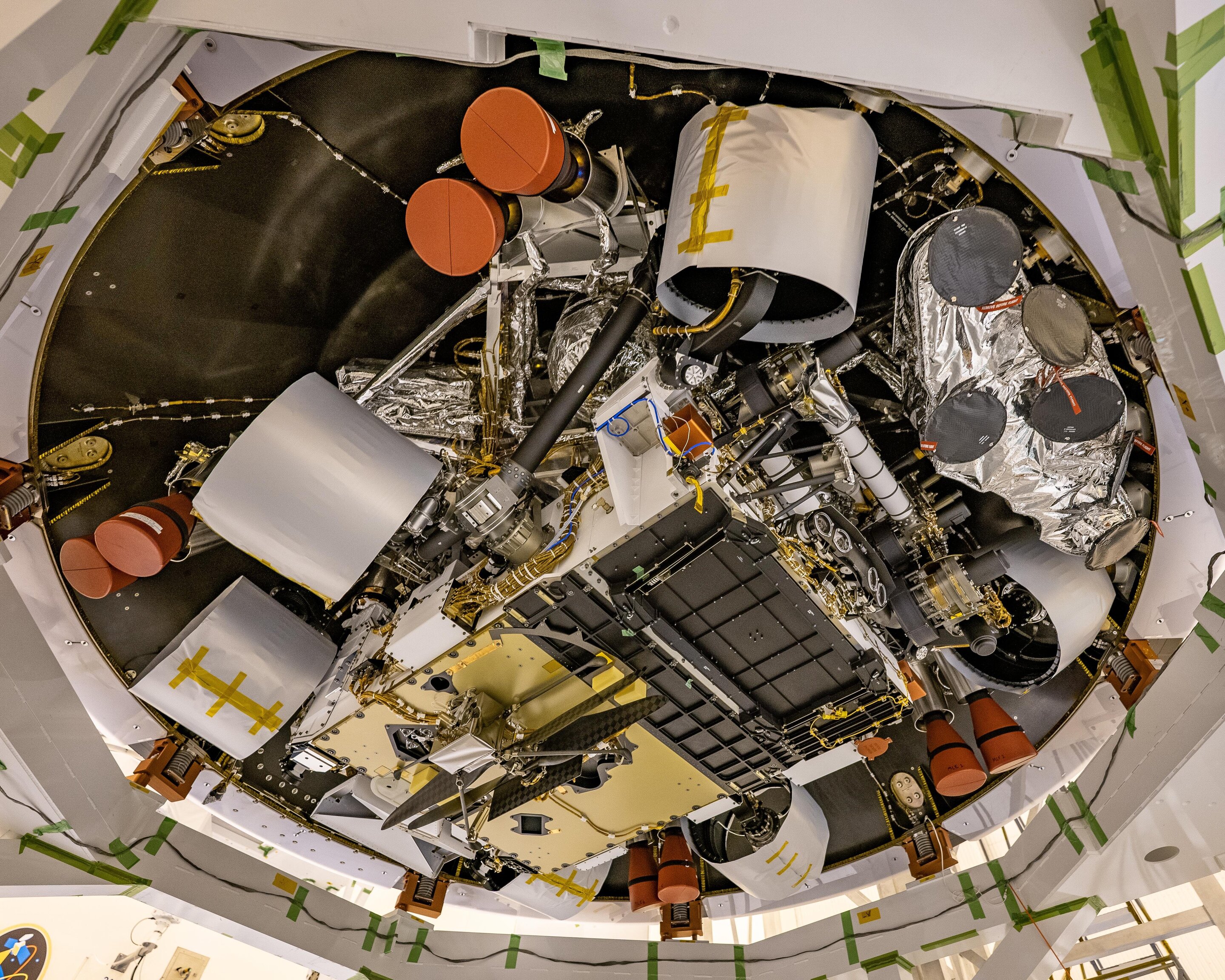
NASA's Perseverance rover spacecraft put in launch configuration
https://phys.org/news/2020-05-nasa-perseverance-rover-spacecraft-configuration.html
Engineers working on NASA's Perseverance rover mission at the Kennedy Space Center in Florida have begun the process of placing the Mars-bound rover and other spacecraft components into the configuration they'll be in as they ride on top of the United Launch Alliance Atlas V rocket. The launch period for the mission opens on July 17—just 70 days from now.

Winston
Lorenzo von Matterhorn
- Joined
- Jan 31, 2009
- Messages
- 9,560
- Reaction score
- 1,748
After 60 Years, Explosion-Powered Rockets Are Nearly Here
Rotating detonation engines could make rockets lighter, faster, and simpler. First imagined in the 1950s, they’re now almost ready for their first flight.
6 May 2020
https://www.wired.com/story/after-60-years-explosion-powered-rockets-are-nearly-here/
Ahmed estimates that eliminating all the turbopump machinery could reduce a rocket’s weight by around 30 percent. It’d also make the engine far less complicated and more fuel-efficient than a conventional one.
A rotating detonation engine doesn’t need these pressurization systems, because the shock wave from the detonation provides the pressure.
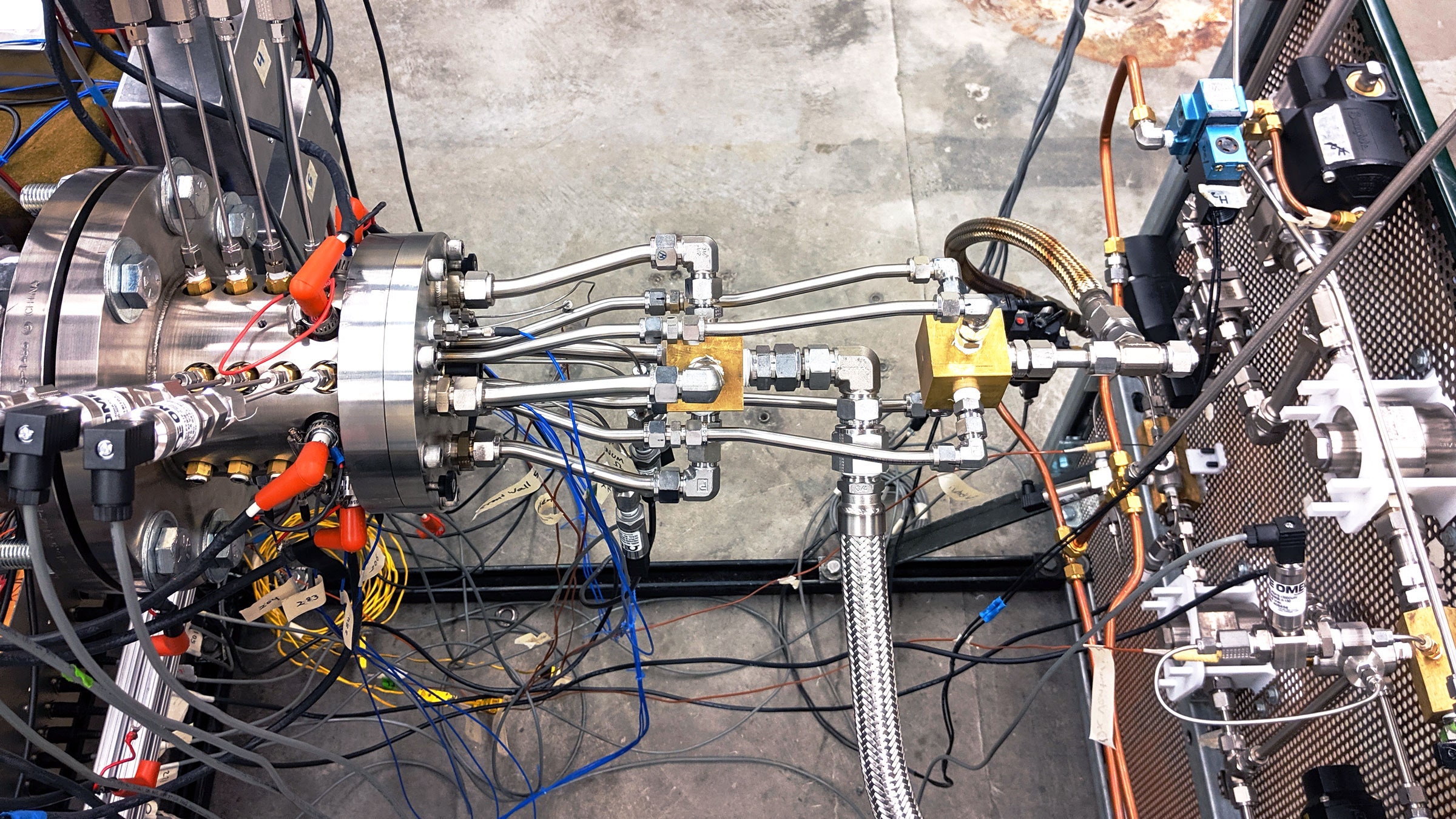
Rotating Detonation Engines Could Propel Hypersonic Flight
It runs on an endless shockwave, but, sadly, it’s still in the prototype stage.
27 Dec 2018
https://www.wired.com/story/rotating-detonation-engine/
Air Force Research Laboratory Rotating Detonation Rocket Engine Development
8 Jul 2018
https://www.researchgate.net/public...Rotating_Detonation_Rocket_Engine_Development
Rotating detonation engines could make rockets lighter, faster, and simpler. First imagined in the 1950s, they’re now almost ready for their first flight.
6 May 2020
https://www.wired.com/story/after-60-years-explosion-powered-rockets-are-nearly-here/
Ahmed estimates that eliminating all the turbopump machinery could reduce a rocket’s weight by around 30 percent. It’d also make the engine far less complicated and more fuel-efficient than a conventional one.
A rotating detonation engine doesn’t need these pressurization systems, because the shock wave from the detonation provides the pressure.

Rotating Detonation Engines Could Propel Hypersonic Flight
It runs on an endless shockwave, but, sadly, it’s still in the prototype stage.
27 Dec 2018
https://www.wired.com/story/rotating-detonation-engine/
Air Force Research Laboratory Rotating Detonation Rocket Engine Development
8 Jul 2018
https://www.researchgate.net/public...Rotating_Detonation_Rocket_Engine_Development
Winston
Lorenzo von Matterhorn
- Joined
- Jan 31, 2009
- Messages
- 9,560
- Reaction score
- 1,748
Scientists Find The First Animal That Doesn't Need Oxygen to Survive
10 May 2020
https://www.sciencealert.com/scientists-find-the-first-animal-that-doesn-t-need-oxygen-to-survive
Some truths about the Universe and our experience in it seem immutable. The sky is up. Gravity sucks. Nothing can travel faster than light. Multicellular life needs oxygen to live. Except we might need to rethink that last one.
Earlier this year, scientists discovered that a jellyfish-like parasite doesn't have a mitochondrial genome - the first multicellular organism known to have this absence. That means it doesn't breathe; in fact, it lives its life completely free of oxygen dependency.
This discovery isn't just changing our understanding of how life can work here on Earth - it could also have implications for the search for extraterrestrial life.
10 May 2020
https://www.sciencealert.com/scientists-find-the-first-animal-that-doesn-t-need-oxygen-to-survive
Some truths about the Universe and our experience in it seem immutable. The sky is up. Gravity sucks. Nothing can travel faster than light. Multicellular life needs oxygen to live. Except we might need to rethink that last one.
Earlier this year, scientists discovered that a jellyfish-like parasite doesn't have a mitochondrial genome - the first multicellular organism known to have this absence. That means it doesn't breathe; in fact, it lives its life completely free of oxygen dependency.
This discovery isn't just changing our understanding of how life can work here on Earth - it could also have implications for the search for extraterrestrial life.
Winston
Lorenzo von Matterhorn
- Joined
- Jan 31, 2009
- Messages
- 9,560
- Reaction score
- 1,748
Purdy.
Aircraft spies gravity waves being sucked into Antarctica’s polar vortex
12 May 2020
https://www.sciencemag.org/news/202...-waves-being-sucked-antarctica-s-polar-vortex
The Southern Ocean is famously stormy, home to waves taller than telephone poles. Yet 50 kilometers overhead, the weather is just as tempestuous, if less obviously so. Powerful waves in the air break and crash, dumping energy into the stratosphere and disrupting winds that help control the climate.
For about 2 decades, researchers have known that a region near 60° South, along the Drake Passage between the tip of South America and Antarctica, is the planet’s hot spot for these so-called gravity waves. They have long suspected that the waves (not to be confused with the gravitational waves rippling through space) are launched by the mountains of the southern Andes and the Antarctic Peninsula, which jut thousands of meters into westerly winds. But puzzlingly, the hot spot lies hundreds of kilometers away from the mountains. Now, a high-altitude aircraft has traced newborn gravity waves rising from the mountains and bending, or refracting, toward that hot spot.
The phenomenon helps explain why climate models predict unrealistically cold temperatures over the South Pole. “It’s really exciting,” says Tracy Moffat-Griffin, an atmospheric physicist with the British Antarctic Survey. “If we can get [refraction] represented in the models that will go a long way towards correcting the cold pole problem.” That, in turn, could improve forecasts of seasonal weather and of the ozone hole that develops over Antarctica in the southern spring.
Lenticular clouds over the Andes’s Torres del Paine:

Aircraft spies gravity waves being sucked into Antarctica’s polar vortex
12 May 2020
https://www.sciencemag.org/news/202...-waves-being-sucked-antarctica-s-polar-vortex
The Southern Ocean is famously stormy, home to waves taller than telephone poles. Yet 50 kilometers overhead, the weather is just as tempestuous, if less obviously so. Powerful waves in the air break and crash, dumping energy into the stratosphere and disrupting winds that help control the climate.
For about 2 decades, researchers have known that a region near 60° South, along the Drake Passage between the tip of South America and Antarctica, is the planet’s hot spot for these so-called gravity waves. They have long suspected that the waves (not to be confused with the gravitational waves rippling through space) are launched by the mountains of the southern Andes and the Antarctic Peninsula, which jut thousands of meters into westerly winds. But puzzlingly, the hot spot lies hundreds of kilometers away from the mountains. Now, a high-altitude aircraft has traced newborn gravity waves rising from the mountains and bending, or refracting, toward that hot spot.
The phenomenon helps explain why climate models predict unrealistically cold temperatures over the South Pole. “It’s really exciting,” says Tracy Moffat-Griffin, an atmospheric physicist with the British Antarctic Survey. “If we can get [refraction] represented in the models that will go a long way towards correcting the cold pole problem.” That, in turn, could improve forecasts of seasonal weather and of the ozone hole that develops over Antarctica in the southern spring.
Lenticular clouds over the Andes’s Torres del Paine:

Winston
Lorenzo von Matterhorn
- Joined
- Jan 31, 2009
- Messages
- 9,560
- Reaction score
- 1,748
The Last Place on Earth We’d Ever Expect to Find Life
Microbes are turning up deep beneath the ocean floor, a sign that life might have fewer limits than scientists once thought.
17 May 2020
https://www.theatlantic.com/science/archive/2020/05/life-microbes-ocean-floor/611755/
The domain below the seafloor can be divided into two distinct regimes: sediment and rock. The former comprises the mud and detritus that accumulates at the bottom of the ocean. This layer resembles a dense sponge in structure: Although 90 percent of its weight might be water, nothing can flow through it efficiently; fluids and chemical compounds slowly diffuse through it instead. Microbial cells essentially get buried there, along with whatever matter they might use for energy.
In shallow areas, particularly near coasts where nutrients are more abundant, this buried life thrives: Millions or even a billion microbial cells may dwell in a cubic centimeter of that sediment. As researchers dig deeper, they find fewer cells.
And yet they always seem to find something. They’ve dug into sediments as far as 2,500 meters below the seafloor—where they’ve uncovered just a few cells per cubic centimeter, approaching the very limits of their detection ability.
These cells barely seem alive, at least by our standards. They live very, very slowly, rarely dividing, their energy consumption at times six orders of magnitude lower than that of cells living in surface habitats. “It might take them 100 years or 1,000 years to divide just once,” Martin Fisk, an ocean ecologist at Oregon State University, says. “They’re very slowly keeping themselves going.”
Steve D’Hondt, an oceanographer at the University of Rhode Island, calls them “zombie cells.” But they are, indeed, alive—they’re simply not operating at familiar time scales. Our observations of the cells’ activity might be akin to a mayfly’s experience of the life of a tree; the insect dies well before it can gain any true understanding of how the tree develops and sustains itself.
[snip]
But something different might be happening in the basalt rocks that lie beneath the sediment. Unlike the hard-packed mud, those rocks have pores and cracks and fissures through which seawater circulates—and with it, organic matter that microbes can feed on.
Last month, a team of scientists in Japan reported life in basalts collected by a 2010 drilling expedition that had reached 120 meters into the crust beneath the ocean, to rocks that were from 33 million to 104 million years old. The age of the rocks alone was exciting, according to Lloyd, who did not participate in the study. “When it formed, dinosaurs were walking the Earth,” she says.
But even more tantalizing were the densities at which the microbes were growing in the rocks. The researchers, using a new technique to precisely enumerate the cells in their samples, found that the microbes were concentrated in a particular subset of the basalt’s mineral-filled fissures. There, they formed something resembling a biofilm, reaching counts of 10 billion cells per cubic centimeter. “[We] didn’t think that there [would be] so many cells in old, cold, hard rocks,” Yohey Suzuki, a geoscientist at the University of Tokyo and the lead author of the study, says.
The researchers were also able to map which types of minerals the cells did and did not associate with. They posit that the bacteria survived by living off of organic matter trapped in those minerals.
“That opens up much, much more of the seafloor that we now know should host microbial life,” Jason Sylvan, a biogeochemist at Texas A&M University who was not involved with the research, says.
In fact, it suggests that the recipe for life might be less stringent than previously expected.
Microbes are turning up deep beneath the ocean floor, a sign that life might have fewer limits than scientists once thought.
17 May 2020
https://www.theatlantic.com/science/archive/2020/05/life-microbes-ocean-floor/611755/
The domain below the seafloor can be divided into two distinct regimes: sediment and rock. The former comprises the mud and detritus that accumulates at the bottom of the ocean. This layer resembles a dense sponge in structure: Although 90 percent of its weight might be water, nothing can flow through it efficiently; fluids and chemical compounds slowly diffuse through it instead. Microbial cells essentially get buried there, along with whatever matter they might use for energy.
In shallow areas, particularly near coasts where nutrients are more abundant, this buried life thrives: Millions or even a billion microbial cells may dwell in a cubic centimeter of that sediment. As researchers dig deeper, they find fewer cells.
And yet they always seem to find something. They’ve dug into sediments as far as 2,500 meters below the seafloor—where they’ve uncovered just a few cells per cubic centimeter, approaching the very limits of their detection ability.
These cells barely seem alive, at least by our standards. They live very, very slowly, rarely dividing, their energy consumption at times six orders of magnitude lower than that of cells living in surface habitats. “It might take them 100 years or 1,000 years to divide just once,” Martin Fisk, an ocean ecologist at Oregon State University, says. “They’re very slowly keeping themselves going.”
Steve D’Hondt, an oceanographer at the University of Rhode Island, calls them “zombie cells.” But they are, indeed, alive—they’re simply not operating at familiar time scales. Our observations of the cells’ activity might be akin to a mayfly’s experience of the life of a tree; the insect dies well before it can gain any true understanding of how the tree develops and sustains itself.
[snip]
But something different might be happening in the basalt rocks that lie beneath the sediment. Unlike the hard-packed mud, those rocks have pores and cracks and fissures through which seawater circulates—and with it, organic matter that microbes can feed on.
Last month, a team of scientists in Japan reported life in basalts collected by a 2010 drilling expedition that had reached 120 meters into the crust beneath the ocean, to rocks that were from 33 million to 104 million years old. The age of the rocks alone was exciting, according to Lloyd, who did not participate in the study. “When it formed, dinosaurs were walking the Earth,” she says.
But even more tantalizing were the densities at which the microbes were growing in the rocks. The researchers, using a new technique to precisely enumerate the cells in their samples, found that the microbes were concentrated in a particular subset of the basalt’s mineral-filled fissures. There, they formed something resembling a biofilm, reaching counts of 10 billion cells per cubic centimeter. “[We] didn’t think that there [would be] so many cells in old, cold, hard rocks,” Yohey Suzuki, a geoscientist at the University of Tokyo and the lead author of the study, says.
The researchers were also able to map which types of minerals the cells did and did not associate with. They posit that the bacteria survived by living off of organic matter trapped in those minerals.
“That opens up much, much more of the seafloor that we now know should host microbial life,” Jason Sylvan, a biogeochemist at Texas A&M University who was not involved with the research, says.
In fact, it suggests that the recipe for life might be less stringent than previously expected.



